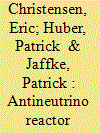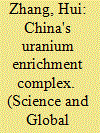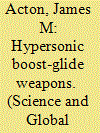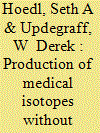|
|
|
Sort Order |
|
|
|
Items / Page
|
|
|
|
|
|
|
| Srl | Item |
| 1 |
ID:
142271


|
|
|
|
|
| Summary/Abstract |
In this article a case study of the application of antineutrino safeguards to a real-world scenario, the North Korean nuclear crisis in 1994, is presented. Detection limits to a partial or full core discharge in 1989 based on actual IAEA safeguards access are derived and it is found that two independent methods would have yielded positive evidence for a second core with very high confidence. To generalize these results, detailed estimates for the sensitivity to the plutonium content of various types of reactors, including most types of plutonium production reactors, are presented, based on detailed reactor simulations. A key finding of this study is that a wide class of reactors with a thermal power of 0.1–1 gigawatt can be safeguarded achieving IAEA goals for quantitative sensitivity and timeliness with antineutrino detectors adjacent to the reactor building. Antineutrino reactor monitoring does not rely on the continuity of knowledge and provides information about core inventory and power status in a timely fashion. The necessary detection systems do not exist yet but are expected to become available within two to five years.
|
|
|
|
|
|
|
|
|
|
|
|
|
|
|
|
| 2 |
ID:
142267


|
|
|
|
|
| Summary/Abstract |
This article presents a model to estimate North Korea's uranium enrichment capacity and to identify probable bottlenecks for scaling up that capacity. Expert assessment is used to identify and estimate the size of key centrifuge materials and component stockpiles. Bayesian probability networks are used to characterize uncertainties in these stockpiles and a deterministic optimization model to estimate the capacity of North Korea's uranium enrichment program given the assumed components and materials constraints. A Monte Carlo simulation model is used to propagate uncertainties through the optimization model. An illustration of this approach, based on the opinions of three experts, suggests that North Korea was likely (about 80 percent chance) to have a larger uranium enrichment capacity than what was displayed to visitors to the Yongbyon nuclear complex in 2010. The three most important bottlenecks to increases in enrichment capacity are the availability of pivot bearings, maraging steel, and high-strength aluminum. The nature of the model allows it to be easily updated as new information becomes available about centrifuge materials and component stockpiles.
|
|
|
|
|
|
|
|
|
|
|
|
|
|
|
|
| 3 |
ID:
142265


|
|
|
|
|
| Summary/Abstract |
New public information allows a fresh estimate of China's current and under-construction uranium enrichment capacity. This paper uses open source information and commercial satellite imagery to identify and offer estimates of the capacity of China's 10 operating enrichment facilities, located at 4 sites, using centrifuge technology most likely based on adapting Russian technology. The total currently operating civilian centrifuge enrichment capacity is estimated to be about 4.5 million separative work units/year (SWU/year), with additional capacity estimated to be about 2 million SWU/year under construction. Also China could have an enrichment capacity of around 0.6 million SWU/year for non-weapon military uses (i.e., naval fuel) or dual use. These estimates are much larger than previous public estimates of China's total enrichment capacity. Further expansion of enrichment capacity may be likely since China will require about 9 million SWU/year by 2020 to meet the enriched uranium fuel needs for its planned nuclear power reactor capacity of 58 gigawatts-electric (GWe) by 2020 under its policy of self-sufficiency in the supply of enrichment services.
|
|
|
|
|
|
|
|
|
|
|
|
|
|
|
|
| 4 |
ID:
142270


|
|
|
|
|
| Summary/Abstract |
This article examines possible modifications of Iran’s IR-40 (Arak) heavy-water reactor that would limit its plutonium production without compromising its usefulness for civilian purposes. The proposed modifications only involve the fuel composition, avoid changes to the fuel and core geometry, and therefore have the advantage of minimizing the overall complexity and cost of conversion as well as shortening the time period required to implement these modifications. The suggested changes would significantly reduce the reactor’s production of plutonium from 7–9 kilograms to less than 1 kilogram per year. The article also examines key safety parameters, medical isotope production rates, and uranium resource requirements for all modifications considered. The analysis is relevant beyond the case of Iran’s Arak reactor and may provide some future guidance for converting other heavy-water reactors that continue to operate today.
|
|
|
|
|
|
|
|
|
|
|
|
|
|
|
|
| 5 |
ID:
142266


|
|
|
|
|
| Summary/Abstract |
The United States, Russia and China are developing hypersonic boost-glide vehicles. A simple model of their trajectory is developed by assuming that the vehicle does not oscillate during the transition to equilibrium gliding. This model is used to analyze U.S. Department of Defense data on test flights for the Hypersonic Technology Vehicle-2. This glider's lift-to-drag ratio—a key performance parameter—is estimated to be 2.6. The model is also used to calculate the tactical warning time that a boost-glide attack would afford an adversary. Other aspects of boost-glide weapons’ military effectiveness are explored. Approximate calculations suggest that, compared to existing non-nuclear weapons, boost-glide weapons could penetrate more deeply but would be less effective at destroying silos. The distance at which a boost-glide weapon armed with a particle dispersion warhead could destroy a mobile missile is also calculated; it is expected to be significantly larger than for an explosive warhead.
|
|
|
|
|
|
|
|
|
|
|
|
|
|
|
|
| 6 |
ID:
142264


|
|
|
|
|
| Summary/Abstract |
Verification of current nuclear arms control treaties between United States and Russia relies primarily on the verification of delivery vehicles. Warheads are counted indirectly via the delivery vehicles that they are associated with. As states move to lower numbers of nuclear weapons in their arsenals, verification will likely pose complex challenges. Most importantly, future nuclear disarmament treaties may place limits on the total number of nuclear weapons in the arsenals. Their verification would require inspections of individual nuclear warheads without revealing secret information. Confirming the authenticity of nuclear warheads and perhaps also of warhead components is at the center of the verification challenge for future reductions in the nuclear arsenals. This paper provides an overview of the development of verification systems, and highlights the challenges and the opportunities for future research in this area.
|
|
|
|
|
|
|
|
|
|
|
|
|
|
|
|
| 7 |
ID:
142269


|
|
|
|
|
| Summary/Abstract |
This article examines the current capability of accelerator technology, which is rapidly improving, to produce medical isotopes. A detailed analysis of 12 medical isotopes that are in active diagnostic and therapeutic use and typically made in nuclear reactors shows that accelerator-based technologies, such as linear accelerators, cyclotrons, and spallation neutron sources, could meet medical demand for these isotopes, without the use of enriched uranium and with low proliferation risk. The feasibility of accelerator-based production of an additional 70 isotopes that have a potential medical use is also discussed.
A simple estimate suggests that accelerators can produce isotopes at a cost comparable to reactors. This article includes four case studies that illustrate the recent choices that emerging market countries have made when expanding domestic medical isotope production. Technical, commercial, and regulatory steps for commercialization are also described. The article concludes with policy suggestions that would increase the adoption of accelerator-based medical isotope production.
|
|
|
|
|
|
|
|
|
|
|
|
|
|
|
|
| 8 |
ID:
142268


|
|
|
|
|
| Summary/Abstract |
An evaluation of terrain characteristics provides a way to make geologic interpretations for denied-access sites. This contribution illustrates the utility of this approach by developing a revised geologic map of the North Korean test site through reconnaissance-based geomorphometrics (defined as the science of quantitative land surface analysis) and geospatial investigation. This study provides a way to quantify the geologic differences at the test site and suggests that geologic factors contributed to the prompt release of detected radionuclides associated with the 2006 nuclear test event compared to the 2009 and 2013 events. This method is relevant for test monitoring by providing: 1) A better understanding of host rock integrity and geologic coupling characteristics; 2) A means to facilitate a more accurate determination of explosive yields; 3) A better understanding of event containment and the likelihood of venting, and 4) An enhanced understanding of potential radionuclide transport mechanisms that might assist in future monitoring and verification of clandestine tests.
|
|
|
|
|
|
|
|
|
|
|
|
|
|
|
|
| 9 |
ID:
142272


|
|
|
|
|
| Summary/Abstract |
The growing concern about nuclear terrorism threats has enhanced the need to develop fast and accurate nuclear forensics analysis techniques for nuclear material source attribution and to create a credible nuclear deterrence. Plutonium produced as a by-product in nuclear reactor fuel, especially in fuel discharged at low burn-up (1 to 2 MWd/kg), is potentially weapons usable material. In the event of plutonium interdiction from a smuggling act, its origin has to be established through nuclear forensics attribution methods before any response is initiated against this malicious act. The characteristics of separated plutonium from discharged reactor fuel and the associated fission product traces depend on factors such as the reactor type (thermal or fast reactor), fuel burn-up, irradiation history, and the chemical process used to separate plutonium. A new methodology of using trace fission product to plutonium ratios for nuclear forensics attribution of plutonium to the type of reactor used for its production is presented along with results obtained for case studies of a fast neutron spectrum breeder reactor and a thermal neutron spectrum reactor using open literature design information of these two types of nuclear reactors.
|
|
|
|
|
|
|
|
|
|
|
|
|
|
|
|
|
|
|
|
|